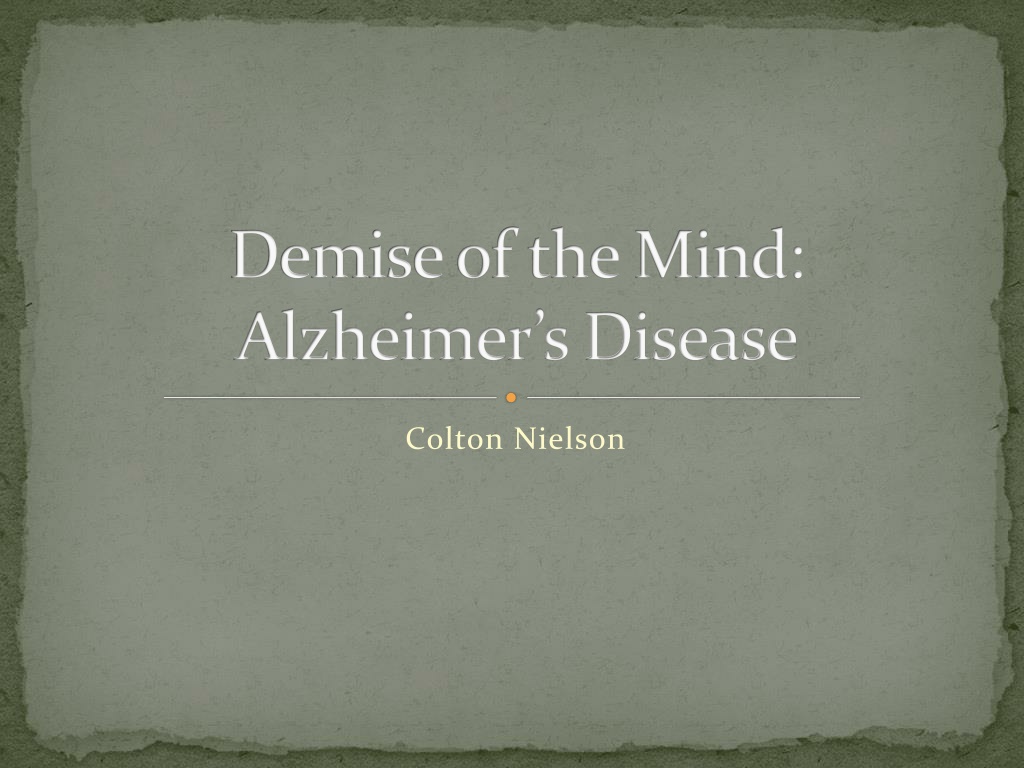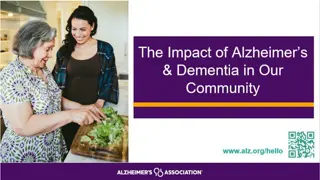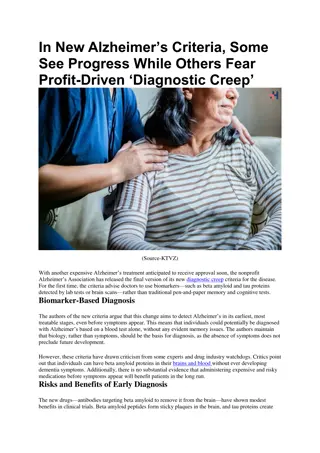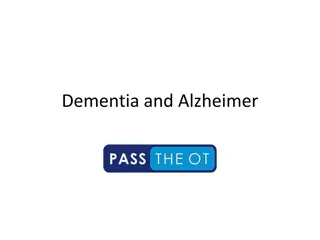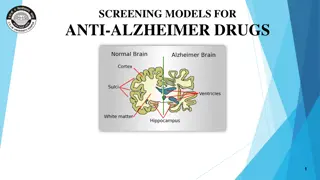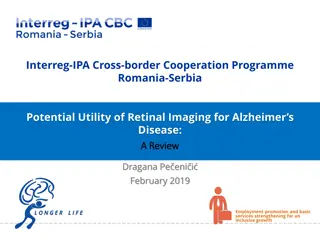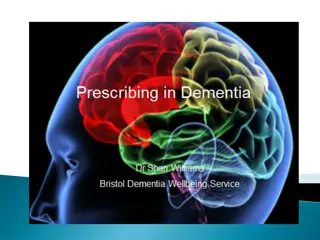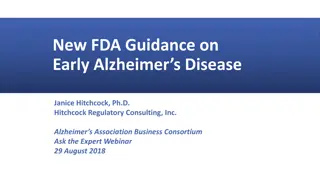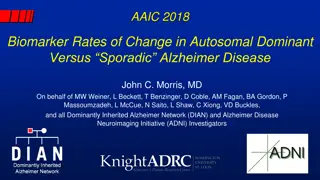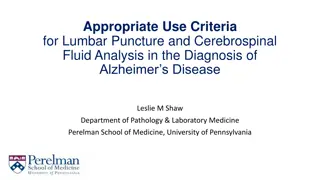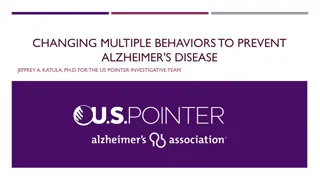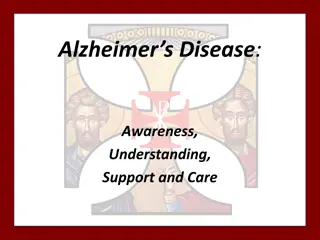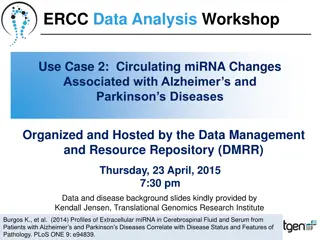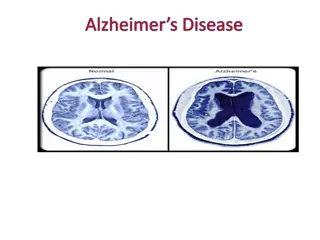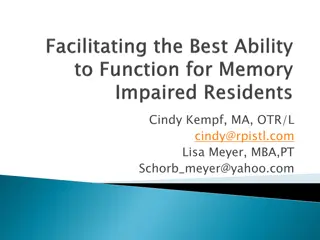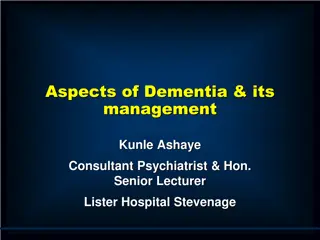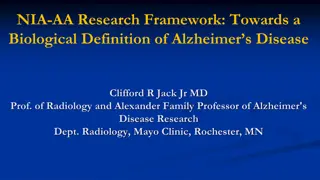Understanding Alzheimer's Disease: Facts, Stages, and Impact
Alzheimer's Disease, first discovered in 1906, is a progressive brain condition that affects memory and cognitive function. It is the seventh leading cause of death in the U.S., with significant economic costs and a global impact. Risk factors include age, low mental ability in early life, head injuries, and vascular diseases. The disease progresses through three stages, each with distinct symptoms and durations. Early diagnosis is crucial for managing the condition and providing appropriate care.
Download Presentation

Please find below an Image/Link to download the presentation.
The content on the website is provided AS IS for your information and personal use only. It may not be sold, licensed, or shared on other websites without obtaining consent from the author. Download presentation by click this link. If you encounter any issues during the download, it is possible that the publisher has removed the file from their server.
E N D
Presentation Transcript
Demise of the Mind: Alzheimer s Disease Colton Nielson
Todays Roadmap of Alzheimers General Introduction History/Facts Risk Factors The 3 Stages Mechanisms of Alzheimer s Drugs The cutting edge: Cure?
What is Alzheimers Disease? First discovered by Dr. Alois Alzheimer in 1906 Alzheimer s disease (AD) is an irreversible, progressive brain disease that slowly destroys memory and cognitive skills, and eventually results in death of the patient Complex neurodegenerative disorder Increasing age is the greatest risk factor Probability of occurrence doubles every 5 years after the age of 60
A breakdown of Alzheimers Disease Currently 7thleading cause of death in U.S. Estimated U.S. economy dollar losses of $1.75+ trillion Cost of annual patient care in U.S. is $100+ billion Annual costs of Alzheimer s Stricken patient in U.S. is $40,000 + Effects 37 million people worldwide
Predisposed Risk Factors Age Low mental ability in early life Reduced mental and physical activity in late life Head injuries Vascular diseases: hypertension and atherosclerosis, smoking, obesity, and diabetes Decreased reserve capacity of the brain Reduced brain size Low educational and occupational status Down s Syndrome or other forms of mental retardation
The ThreeStages of Alzheimers Disease Scientists have debated the number of differentiable stages-today, three is widely accepted number
Stage 1 of Alzheimers Disease Typically lasts 2-4 years leading up to and including diagnosis Symptoms: recent memory loss that can effect job performance Examples include: Getting lost on the way to work Taking longer with routine chores Trouble handling money or paying bills
Stage 2 of Alzheimers Disease Duration of 2-10 years Symptoms include: increasing memory loss and confusion with a shorter attention span Examples of Stage two Alzheimer s: Problems recognizing close friends and family Problems finding the right words Rapid swing s in body weight Necessity of full-time supervision
Stage 3 of Alzheimers Disease Terminal Stage Duration of 1-3 years Symptoms include: inability to identify family members or themselves in a mirror Examples: rapid weight loss Loss of interest in self care Loss of communication Loss of control of bowels and bladder
Diagnostic Methods Only way to diagnose is autopsy of the brain There are several diagnostic methods Physicians perform take a detailed patient history Take a past family medical history Physical and neurological examinations Neuropsychological testing-measure memory, language, simple math skills CT scans or MRI tests which can detect strokes or tumors or changes in brain structure that suggests early signs of AD
Genetics Behind Alzheimers Disease Two forms: familial and sporadic Familial-autosomal dominant disorder with early onset 1stmutation causing familial found in amyloid precursor protein (APP) gene on chromosome 21 Most mutations are in the homologous presenilin 1 (PSEN1) and presenilin 2 (PSEN2) genes Familial is uncommon: occurrence rate well below 0.1%
Genetics Behind Alzheimers Disease Sporadic disease linked with apolipoprotein E (APOE) Heterozygotes for the APOE allele experience 3x the risk of developing the disease compared to individual without Homozygotes increase risk of disease over 15x Mechanism: APOE allele modifies age of onset-each allele lowers age of onset of disease by 10 years
What happens within the Brain Get diffuse cerebral atrophy with widened sulci and enlarged ventricles Destruction of nerve synapses has been linked with correlation of cognitive decline Lesions occur and neurons are further destroyed
Physiology of the Brain Plaques are known as microscopic clumps of a protein called beta-amyloid peptide and tangles are twisted microscopic strands of the protein tau. Believed beta-amyloid may directly interact with tau to accelerate formation of neurofibrillary tangles. Beta-amyloid activates inflammatory response from brain
A Hypothesis Behind Alzheimers Disease Amyloid-Beta PP is type-1 transmembrane protein Cleaved by two proteases (beta and gamma secretases) to from Amyloid beta Amyloid beta occurs normally in plasma and CSF Mismetabolismof Amyloid-beta PP is believed to initiate event that leads to aggregation of Amyloid- beta Strong evidence in favor of hypothesis: Extra Chromosome 21 in Down s Syndrome, which contains the Amyloid beta PP gene, leads to increased synthesis of Amyloid beta PP and early onset of Alzheimer s disease
Problems with Acetylcholine Post-mortem studies show reduced uptake and reduced release Without this critical neurotransmitter, memory loss associated with the onset of Alzheimer s Disease is observed many symptoms of dementia explained There was false hope that restoring cholinergic balance by AchE inhibitors would reverse progression Still main target used today
Tacrine (Cognex)-The first Cholinesterase Inhibitor 1993-FDA approved as first Alzheimer drug Studies-delay institutionalization up to 1 year- reduce costs up to $3.6 billion annually Estimated lifetime savings of $10,000
Tacrine-The Other Side of the Story Unfortunately, associated with sever hepatotoxicity Affected its permeability- often eliminated too soon or too late Induced variable drug amounts in body Attributed to poor selectivity for AchE as also binds butyrylcholinesterase Lead to 2ndgeneration drugs
Donepezil (Aricept) Can cross the BBB with nearly 100% efficiency-approved for all stages of treatment File:Donepezil skeletal.svg Highly selective reversible inhibitor of AchE Unaffected by food Long plasma half-life of 70 hours- administered once daily Most widely used across the world Reduced Side effects
Donepezil (Aricept) Cognition advantages up to 1 year
Rivastigmine(Exelon) Although short half life of 2 hours, cholinesterase inhibition in brain last up to 10 hours Therefore, identified as pseudo-irreversible inhibitor of AchE and BuchE Short half life leads to 2x daily dosing
Galantamine(Reminyl) Isolated from Galanthus woronowii Competitive and reversible AchE inhibitor Much less potent than Tacrine against BuchE Drug acts directly on nicotinic receptors increasing release of acetycholine http://bp0.blogger.com/_AE1cFdPaaME/R-lkhznu05I/AAAAAAAABJo/HXLsIizPV08/s400/IMG_8657.jpg Short half life of 8 hours-2x daily
Memantine(Ebixaor Namenda) 2003-released onto market. NMDA (N-methyl-D-asparate) receptor antagonist regulates activity of glutamate- chemical messenger involved in learning and memory Up until now-drugs weren t neuro- protective and only enhanced cognitive state Protects brain cells against excess glutamate-released by damaged cells of patients
Memantine(Ebixaor Namenda) Diseased brain-attachment of glutamate to NMDA receptors permits calcium to flow freely into cell Over time-leads to chronic overexposure to calcium which speeds cell damage Memantineslows progress of disease up to 1 year
Drug Administration Oral route long preferred Alzheimer s drugs associated with first-pass metabolism-leads to reduction in bioavailability of medications Recent studies show greater patient cooperation with transdermal route, buccal, and nasal routes All Alternative ways to deliver a drug to CNS without associated oral administration side affects
Alternative Treatments to Alzheimers Disease Alzheimer s lower in countries with low fat and calorie diets Essential fatty acids-improvement in mood and mental function than placebo Vitamin E depletion in patient-2000 IU daily can delay onset Vitamin C in synergy enhanced effects Thiamine (B1)-marked improvements in mental function and assessment scores Vitamin B12 and Melatonin also show potential
Future Drug Targets Amyloid Protein: beta-secretase and gamma-secretase Tau protein-main ingredient of tangles- other hallmark abnormality Anti-inflammatory drugs Insulin release
Future Drug Targets Within 3-4 years, next generation of drug therapy expected to reach the market. Scientists have discovered how the beta-amyloid protein fragment is clipped from its parent compound amyloid precursor protein (APP) by two enzymes: beta-secretase and gamma-secretase HUGE area of research-develop medications aimed at every possible point in amyloid protein Especially these two enzymes
Future Drug Targets Tau Protein: main ingredient of tangles-other hallmark brain abnormality Researchers are attempting to develop drugs that bind tau molecules Want to keep them from collapsing and twisting into tangles-destructs critical cell transport mechanisms Anti-inflammatory drugs will attempt to offset inflammation response caused by the disease
A Bright Future: Insulin Reduced glucose utilization and energy metabolism occurs early in the course of Alzheimer s Disease- correlates with impaired cognition Regulated by insulin and insulin growth factor 1 (IGF- 1) Reduced levels of insulin and IGF-1 polypeptide genes found in advanced Alzheimer s disease patients In frontal lobe-progressively reduced levels of mRNA corresponding to insulin, IGF-1, and IGF-2 polypeptides and their receptors, and tau were found as the disease advanced
A Bright Future: Nitrosamines Nitrosamines formed by chemical reaction between Nitrites or other proteins Nitrates and Nitrates-found in cured meats, cheese products, as well as beer and bottled water Generated under strong acid conditions-stomach or from broiling or frying foods Can prevent by removing sodium nitrite content in food http://upload.wikimedia.org/wikipedia/commons/thumb/0/0b/Nitrosamine-2D.png/150px-Nitrosamine-2D.png
A Bright Future: Nitrosamines Strong parallels between age-adjusted increases in death rate from Alzheimer s in human exposure to nitrates, nitrites, and nitrosamines Nitrosamines found in preserved foods as well as fertilizer Society has moved to diet rich in amines and nitrates- leads to increased nitrosamine production Increased exposure-caused both to processed foods and crops leeching nitrates from the soil and contaminating water supplies used for crop irrigation http://upload.wikimedia.org/wikipedia/commons/thumb/0/0b/Nitrosamine-2D.png/150px-Nitrosamine-2D.png
Nitrosamines: Mechanism of Action Become reactive at cellular level- changes gene expression and leads to DNA damage The changes induced by nitrosamines are similar to those of aging, as well as Alzheimer s Disease Produce biochemical changes inside cells and scientists are beginning to believe Alzheimer s could be caused by nitrosamines found in processed foods, and water http://upload.wikimedia.org/wikipedia/commons/thumb/0/0b/Nitrosamine-2D.png/150px-Nitrosamine-2D.png
A Bright Future: Inflammation Cascading basic science, genetic, and clinical evidence supports key role of the inflammatory cytokine, TNF, in the pathogenesis of Alzheimer s Disease http://nrimed.reachlocal. net/videos/dementia- patient-recognizes-wife- after-inr-treatment/ Inflammation of the brain long known as a strong contributor to Alzheimer s Disease
Readings Wilkinson, David . "Pharmacotherapy of Alzheimer's disease." Psychiatry 4.1 (2005): 43-47. Print. Alzheimer's Association. "The Journal of Alzheimer's Association." 2010 Alzheimer's Facts and Figures 1st ser. 6.2 (2010): 158+. Print.
Homework Questions List the 4 FDA approved Alzheimer s Disease drugs and draw their structure These FDA approved drugs have not always been available for drug treatment. Prior to the use of these drugs, Alzheimer s patients were commonly treated with WHAT forms of drugs to minimize their abnormal behavior? What is Alzheimer s disease (define) How are Nitrosamines formed? How can nitrates and nitrites enter the body?
